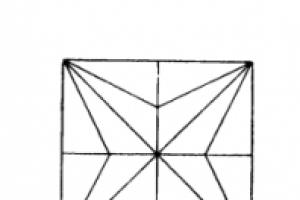The installation of a heating system is the most expensive item in the estimate overhaul or construction. The operational characteristics and energy costs of the owners in the winter depend on the correct installation and the features of all the elements of this facility.
Gradually replacing outdated tee wiring. This is due to a number of its advantages. The master should learn how to arrange such a wiring independently, as well as what its main features are, before starting installation.
general characteristics
Can be done using various wiring. The beam system is also called the collector system. Each radiator in the building is supplied to a separate pipe. Each of them has its own pipe returning to the collector. Radiators with this connection are a separate element. They do not depend on other heating devices in the network and are supplied to the collector in parallel.
The collector is a large device. It is responsible for supplying coolant to each individual circuit. If it is necessary to repair one battery, the heating system continues to operate as before. Only one radiator is cut off.
according to the tee scheme, it involves a smaller number of pipes. However, installation costs are recouped during the operation of the system. The positive economic effect of using beam distribution V big house or a cottage with two or more floors.
Advantages and disadvantages
Characterized by some features radial wiring of the heating system. Advantages and disadvantages such an organization must be considered before installation. The disadvantages include a larger number of pipes and fittings. This significantly increases the cost of repairs. The tee circuit is much cheaper to install. Also a large number of connections if connected incorrectly can lead to frequent system breakdowns.

However, all these disadvantages pale against the background of the advantages of radiant heating. In this case, the system quickly pays for its installation cost. The ability to control the heating in each room significantly reduces energy costs. When organizing such a system, there are many joints and joints. The master has easy access to them. Therefore, when carrying out repairs, this factor greatly facilitates the work.
The beam system pipes can be hidden under the floor, in the thickness of the wall, or simply behind curtains. A properly planned scheme allows you to remove unattractive communications from view. The tee circuit does not provide such an opportunity to home owners.
System elements
Consists of several required elements. The main one is the boiler. When calculating its power, the area of the premises, as well as the heat loss of the building, are taken into account.
The circuit includes a circulation pump. There are systems with natural coolant circulation. However, they are less effective. Today, almost all radiant heating schemes include a pump. It forces the heated liquid to move along the circuits at a certain speed. This is how we manage to maintain optimal mode heating the room.

The collector is a distribution unit. It is responsible for optimal nutrition of all circuits. This element may include various control and shut-off equipment. The presented devices are installed in a special cabinet. This allows you to protect your equipment and hide it from prying eyes.
Circulation type
Can use the principle of natural or forced circulation. In the first case, the coolant is distributed through pipes and radiators by gravity. This requires installing pipes large diameter. This is a simple but less effective system. It is only suitable for small one-story house, to which electricity is not supplied.

IN modern construction beam systems are used in combination with a pump. It provides forced circulation of the coolant. The pump is installed on the supply or return circuit. It works with a certain power. Such a device is necessary for the heating system of a large or two-story cottage.
Thanks to the many advantages, as well as the reasonable cost of circulation pumps, today this installation option is used almost everywhere.
Design
Calculation of a radiant heating system carried out at the design stage. To do this, you need to draw on paper detailed diagram with dimensions. All elements are indicated on it. If necessary, the drawing can be ordered from a special organization.

First you need to evaluate the existing features of the room. The rooms should not be decorated. It is best to hide the pipes in the floor under the screed. The plan also indicates radiators and their location (on the wall under the window). The number of sections and their internal volume depend on the material of the convector, as well as the thickness of its walls. In accordance with the parameters specified by the manufacturer, the required volume of coolant for each battery is calculated.
According to the radial scheme, it is characterized by some additional heat losses. The heated liquid is supplied to the batteries through pipes, the length of which will be greater than in a tee circuit. This feature must be taken into account when making calculations.
The plan indicates where the pipes will be laid. Pressure gauges, thermometers, shut-off valves are added to the equipment. Before installation, all elements of the main and additional equipment should be carefully considered. The sequence of their installation is also indicated in the diagram.
Manifold selection
Includes a collector (comb). This element has pipes for the inlet and outlet of the coolant. For a beam circuit, two types of collectors should be installed.

The first of these will be the input comb. A pump is connected to it, as well as a coolant distribution valve. It can be three- or two-way. The valve contains a thermometer. It is installed in the collector housing. The device transmits information to the valve. It opens or closes the valve, mixing hot liquid into the circuit.
The outlet manifold collects the cooled coolant, which returns to the boiler. The heating device heats it up again. Additionally, a balancing flow controller can be installed on this pipe. The collector group ensures the stability of the system. It is responsible for optimizing and balancing the heating of the coolant in the system.
Pipe selection
Which is mounted according to a beam pattern, requires correct selection pipes Communications must be flexible enough to avoid installing a large number of connections. Pipes made of cross-linked polyethylene are best suited for these purposes. Such products are sold in coils.
Polyethylene pipes that are suitable for radiant heating systems must have an airtight layer. When using conventional varieties, air enters the system. It leads to the development of corrosion of metal elements and rapid failure of equipment.
To connect the collector to the boiler, ¾-inch pipes are used. Radiators can be connected to the comb using communications with a cross-section of ½ inch. This is possible if used in a pump. Otherwise, the diameter of the pipes may be larger.
Installation features
Can be installed by the owners of a private home. To do this, it is necessary to allocate a separate room for the arrangement of the boiler room.

After installing the heating device, the comb is installed immediately after it. The equipment must be kept in a protective box. The collector must be freely accessible. A pressure gauge and thermometer are installed at the coolant outlet. The Mayevsky valve and other safety devices allow you to stabilize the pressure in the system.
Shut-off valves allow, if necessary, to carry out preventive maintenance or repair of equipment. After installation, the equipment is checked. If everything is normal, the pipes are poured into the screed.
There is quite a wide variety of autonomous heating systems that are designed to heat private homes. In places where there are regular power outages or where there is no gas main nearby, people prefer traditional Russian stoves. This is the most striking example of a radiant heating system for a private home.
Modern radiant heating
Wiring of a radiant heating system
Russian stoves are quite large, which sometimes creates difficulties in installing them in country houses and even more so in city apartments. However, technology does not stand still; heating systems are modified and adapted to the needs of modern people.
Based on the pipe connections from the collector to the radiators, systems are divided into three types:
- radial;
- two-pipe;
- single-pipe.
The operating principle of radiant heating is based on the fact that wiring is provided separately for each radiator. This is the most significant advantage of this system. If necessary, radiators can be turned on and off in groups or individually.
The system is equipped with a special heat supply valve. If it’s warm outside or household appliances are running in the kitchen, you can tighten the valve a little. Thanks to the ability to regulate the heat supply to the rooms, it is possible to save fuel.
Features and segments of beam distribution

Elements of a radiant heating system
A heating system based on radiant radiation is most suitable for use in apartment buildings or country/private houses with several floors and a large number of rooms. This allows you to increase the efficiency of the entire heating system, guarantees high-quality heat supply and economically requires resources.
The operating principle of a radiant heating system is simple, but has its own characteristics. If the structure has several floors, collectors must be installed on each. Moreover, in some cases it is advisable to install not one, but several collectors on a floor, and run pipes from them. The effectiveness of the equipment will be undeniable if the house is well insulated and heat loss is minimal.
A radiant heating system includes several basic elements necessary for high-quality operation.
- The boiler is the main part. From it heat is supplied to the pipes, and from there to the radiators.
- Circular pumping station, thanks to which the necessary pressure is ensured in the pipes and the coolant circulates.
- A collector with the help of which a uniform supply and distribution of heat is carried out throughout all rooms.
Another component is the closet. It manages to hide the distribution manifold, shut-off valves and pipes. The design is simple, practical and functional.
Radial heating connection diagram

Circulation pump connection diagram
In search of the most optimal type of heating circuit, most often they give preference to radial floor-to-floor piping. The essence of the method is that all pipes and components are hidden in the thickness of the floor. The main distribution body of the system is mounted in a niche in the wall enclosure or in a special cabinet.
To implement the connection diagram, you need a circular pump or several devices that are mounted on each branch or ring. Most often, this scheme is implemented on the basis of one- and two-pipe installation, displacing the tee connection method.
Supply and return manifolds are installed near the riser of a two-pipe system. From them, pipes are run under the floors to each radiator installed on the floor.
Each of the contours should approximately have the same length. If for certain reasons this is not possible, the large circuit must be separately equipped with a circular pump and automatic temperature control.
In this case, the temperature indicators on each circuit will be independent of each other. This is due to the fact that the pipeline will be under the screed. Each radiator is additionally equipped with an air valve. Air vents are usually installed on the manifold.
Before starting work, you need to determine the location of the equipment, make a paper list of everything you need and schematically depict the location of the selected radiators.
Radiant heating system and heated floor
A radiant heating system and a water heated floor are installed in a similar way. Heated floors can be connected to radiators through one manifold. This approach is extremely popular among people who want to insulate floors in some rooms, and not throughout the entire living space.
It is extremely important to provide temperature control, otherwise the room may become too hot or cold. When organizing a heated floor, the pipes must be insulated in one layer. Insulation material 6-10 mm thick allows no more than 30% of heat to pass through.
Advantages and disadvantages

With radiant heating, coolant with the same temperature is supplied to all radiators
The collector-beam heating system has absorbed all the advantages of its predecessors, which explains the popularity of the equipment.
Main advantages:
- Aesthetics.
- From a hydraulic point of view, this is the most advanced heating system. Each battery has individual lines, so the system segments are independent.
- If desired or necessary, you can disconnect any battery.
- All radiators receive water at the same temperature.
- It is possible to equip the system with means of automatic regulation and control of the entire circuit as a whole.
- The number of connections is minimal, there are no tees.
The most significant disadvantage is the high cost of equipment and its installation. The costs of expensive manifolds and increased pipeline footage cannot be compensated for by the lack of fittings. If the building has several floors, the cost of the equipment doubles, triples, etc., depending on the number of floors. The installation itself under the floors further involves extra work for flooring installation.
Upgrading any radiant system is not particularly difficult; its implementation will require the installation of additional valves with a thermostatic head on each radiator that is connected to the system. Thanks to the thermostat, it is possible to set the most optimal one in a particular case temperature regime. The temperature will not rise above the parameters set by humans.
It is advisable to modernize the heating system in those buildings where each room is demarcated by purpose. For example, to store goods you need one temperature range, but for people to stay comfortably in the room, a different one is needed.
In the search for the most suitable heating system, it usually turns out that the radiant system is best suited, since it has much more advantageous features than disadvantages. The latter rest only on finances; the efficiency and productivity of the system are at their best. Average duration The operating life of heating equipment is 50 years.
All types of heating systems have a common set of design elements. This is a boiler that serves as a source of heat generation; circuit consisting of pipes and. Differences various types consist in different schemes pipe installations.
One of the most famous wiring is considered to be a radiant heating system.
The main difference between a radiant heating system and other systems is that here, with the help of a collector unit, each battery has its own separate pipes for supplying and discharging liquid.
Thanks to in a similar way, you don’t have to turn off the entire system in case of breakdown individual elements. There will also be no need to install, which will significantly simplify installation and reduce the final cost.
Considering the advantages of this system, it is worth noting:
1. Easy installation, thanks to the use of pipes and a small amount.
2. The pipeline “run” into the walls and floor does not spoil the interior.
3. Increased functionality when installing additional elements (for example: thermoregulation sensors, air vents, etc.)
4. Possibility of setting different specific temperatures in individual rooms.
5. Repair and replacement separately, without shutting down the entire system.
6. Uniform heating.


Due to the “fan” layout of this wiring, almost always all pipes are installed inside walls or floors. This is done to preserve the aesthetic appearance of the room and convenience. When arranging the premises, a radiant heating system is also used. Pipes are laid in concrete screed gender, but at the same time everything connecting elements are on the surface. This is done in order to prevent coolant leakage under the screed.
The main disadvantage of a radiant heating system is the large number of materials used, due to its large footage.
Also mainly used here forced circulation coolant, which means circulation pumps will be required.
In order to achieve high system efficiency, you should pay attention to the following points:
- A unit equipped with a thermostat should be located away from hot appliances. (for the veracity of testimony)
- Circulation pump It is mainly located on the return pipe, the temperature of which is significantly lower than the supply pipe.
- The presence of an air release device is required. Or the pump must be equipped with an air vent.
- It is advisable to locate the pump close to the expansion tank.
- Before installing and starting the circulation pump, the system should be flushed and filled with liquid.
Among the advantages of the beam system, it is also worth noting the convenience of adjusting the wiring temperature. If desired, each room can have its own independent temperature.
Also, the use of the beam method is justified in multi-story buildings. In the process technical work or replacement of individual parts will not have to be disconnected heating system throughout the whole house.
A radiant heating system for a private home is also used in facilities with wooden floors. To do this, holes are drilled in the beams slightly wider than the diameter of the pipes. This is necessary so that the structure does not put pressure on the pipeline.

When installing radiant wiring, certain rules must be followed to reduce heat loss:

Radial wiring of the heating system.
In the design of a beam system, one of its main components is the collector unit.

If this system is installed in a multi-story building, the collector is installed on each floor.
Special collector cabinets are provided for the collector unit. Their internal structure is determined by the convenience and accessibility of each element of the collector.
Among the features of beam wiring, the following should be highlighted:
- The minimum number of connections in the circuit is a definite plus. Thanks to this, the system is virtually always hydraulically stable.
- To ensure high wiring efficiency, it is necessary to correctly select the boiler power, take into account heat loss and calculate the heat energy consumption of heating devices.
- It should be taken into account that as the length of the pipes increases, heat loss increases.

Almost always, radial distribution is installed horizontally, with forced circulation and lower liquid supply. The use of a circulation pump allows you to reduce the temperature difference at the inlet and outlet of the pipeline. This significantly increases the efficiency of the system, makes it less bulky and significantly reduces material consumption. When choosing a device, you should pay attention to two main parameters: productivity (cubic meters per hour) and pressure height (in meters).
For the right choice unit, the following pipe characteristics are taken into account for productivity and pressure height:
- Pipe diameter
- Total pipeline length
- The height of the pipeline relative to the position of the circulation pump.
Among other things, the circuit includes a collector unit. Its function is to supply liquid to each heating device and remove it. From the collector, the coolant is sent back to the boiler. Typically, collectors can supply from 2 to 12 circuits. But there are models with larger numbers. Collectors are often equipped with elements of shut-off and control valves and thermoregulation. Thanks to them, the most efficient and acceptable fluid flow in each branch is adjusted. In addition, the presence of air vents is mandatory for a longer service life of the system.
Radiant heating system in an apartment building.
 Radiant heating system in an apartment building
Radiant heating system in an apartment building Almost always, in modern multi-storey buildings, radiant heating systems are installed. The entire circuit is mounted in the wall or, more often, in the floor. The supply and discharge collector units are located in a special niche in the center of the floor premises. Pipes extend from them to each radiator on the floor.
The scheme is carried out in the form of one-pipe or two-pipe installation. The pumps are also installed on individual rings or the entire branch. If possible, each contour is made the same length. Otherwise, each branch is equipped with its own pump and automatic temperature control. The process of adjusting the temperature of each circuit is separate from the others. Each battery must be equipped to bleed air.
Drawing a general conclusion regarding beam distribution, it should be said that this is the most balanced heating circuit, which has a large number of advantages compared to others.
When building a home, the heating system has always been one of the most expensive expenses. The comfort and costs of residents for electricity and other types of fuel during the cold season largely depend on how correctly the heating system is installed. Outdated heating systems are being replaced by increasingly newer and more efficient systems that have better heat transfer, thereby allowing you to save on fuel. These systems are of the beam type, and they require competent design and installation. This article will discuss the radiant heating system and its features. Here we will also consider important points that you should pay attention to when installing the wiring of a radiant heating system.

Two-pipe heating system
Gaining increasing popularity among people autonomous systems heating. They have a lot of different wiring options. Until recently, conventional systems were used autonomous heating, but more recently they were replaced by beam systems. They are also popularly called collectors. The name speaks for itself, since individually each radiator is connected directly to the collector, which distributes the coolant. With this connection of radiators, they are completely independent of each other. In a radiant heating system, other heating devices can be used, which also do not depend on radiators in this system. The radiators here are connected in parallel to the collector. As a rule, the collector is mounted somewhere in a remote part of the room, or hidden in a wall, or in a special cabinet. The collector is sometimes quite large sizes. It all depends on the area of the heated room. The beam system allows you to easily repair a failed radiator without stopping the entire system. A radiator in need of repair should simply be disconnected from the heating system and dismantled.
A conventional heating system uses a two-pipe circuit. It is also called tee. To install this autonomous heating scheme, much fewer pipes are required than for radial heating. But the additional costs for pipes in the beam system are more than recouped due to energy savings. The radiant heating system most clearly reveals its economic effect in residential premises with a large area, especially in multi-storey private buildings.
Pros and cons of the beam system
It is best to weigh all the pros and cons before installing a heating system and decide in advance which system will suit you best. Of course, the beam system has its own characteristics, which also need to be taken into account. Let's start with the negative points.
Disadvantages of the beam system
- This system has, perhaps, only one minus - it larger number elements in its design. In particular - pipes. It also uses more fittings;
- A large number of elements in a given system can increase repair costs. A conventional heating system has a lower estimated cost and is cheaper to repair.
The radiant heating system of a private house requires a more correct approach when connecting all heating devices, since violation of the connection rules is fraught frequent breakdowns systems - as a whole.
Pros of the beam system
But all of the above loses its significance against the background of the general advantages of a radiant heating system. In a very short period of time, a properly designed and installed beam system:
- It will more than pay for itself. It also has a lot of useful and convenient features;
- When using a radiant heating system, you can have a differentiated approach to heating in each room. This approach allows you to more efficiently distribute heat in your home, which entails very large energy savings;
- This system is also convenient in that during its repair you can get unhindered access to pipe connections, which speeds up troubleshooting and troubleshooting;
- In a traditional heating system, hiding pipes is not very easy. The radial system allows pipes to be hidden from view either in the walls or under the floor. If this system is installed correctly, then no components or wiring will be noticeable;
- The correct radial distribution scheme allows you to effectively distribute heat throughout the entire area of your home.
Components for the collector system
The set of elements of a radiant heating system is similar to the set. For both of these systems, the main element is the heating boiler. In order for the radiant system to be effective, you need to carefully approach the issue of selecting the power of the heating boiler. When choosing a boiler, you need to take into account the area of the heated room, but it is also important to take into account heat loss.
The wiring of the radiant heating system also includes a pump that circulates the coolant. The radiant heating system does not work by gravity. Therefore, the vast majority of radiant heating systems have a circulation pump in their design. The pump must also be located in right place. Let's move on to the second very important element of the radiant heating system - the collector.
This element is nothing more than Switchgear. With the help of a collector, coolant is supplied to all segments of the heating system. The Collector includes numerous elements of shut-off equipment that allow you to differentially regulate the temperature of the living space, right down to individual radiators in the rooms. As a rule, the collector is mounted in a separate panel or in a cabinet, which fits perfectly into the interior and is not an eyesore. Now separately about circulation.
Heating circulation methods
The heating system can have several types of coolant circulation. These include:
- Forced circulation method;
With the natural circulation type, the coolant is spontaneously distributed through convection throughout all elements of the heating system. To ensure the best circulation in a natural way, large diameter pipes are used in the heating system. The natural method of coolant circulation, due to its lower efficiency, has some limitations on the area of the heated room. Typically this method is used in small private homes.
The forced circulation method has long proven itself very well. Today on the market you can find a huge number of circulation pumps that are very compact and very efficient. These pumps have a fairly long service life. When installing a radiant system, it is important to correctly adjust the coolant circulation speed. The pump can be installed both on the supply and return side. Using a circulation pump, you can supply coolant to a fairly decent height. When selecting a pump this parameter also needs to be taken into account.
Today, forced circulation, due to its undeniable advantages, is undoubtedly the most popular method of transferring coolant. The advantages also include the very affordable cost of circulation pumps.
Where to start installation?
Typically, all construction activities begin with thoughtful design. Typically, a drawing is created first. To design a radiant heating system, it is necessary to make a similar drawing with all elements and dimensions. If this drawing cannot be made by hand, then it can be ordered from a design organization.
The beginning of the design always begins with an assessment of the room in which the radiant heating system will be installed. It is advisable to do this on early stages construction, until the moment when the premises have not yet been carried out Finishing work. It is better to immediately hide the elements of the heating system in the walls or under the screed. The drawing must detail all elements of the heating system and where they will be located. It is also advisable to provide more detailed information about the heating devices, since the system as a whole will be designed on the basis of this data. It is advisable to indicate the exact volume of heating devices and what materials they are made of. Using this information, you can accurately calculate how much coolant will be used in the heating system.
A very important point to pay attention to is additional heat loss. In a radiant heating system, the length of the pipes is slightly higher than in a conventional two-pipe system, and this factor is also important to take into account when designing and calculating a radiant heating system.
The drawing must also include a plan for laying communications for the heating system. It must also indicate all measuring instruments, as well as adjusting and locking elements. The drawing also indicates everything additional elements, which can be used in the installation of a heating system. detailed information This additional equipment and its installation are also described step by step.
Selecting a distribution manifold

The collector is also popularly called a “comb”, because this element of the heating system looks like a hair comb. The base of the collector uses a pipe to which numerous pipes are connected. A radiant heating system uses two collectors. One manifold is installed on the supply, and the other on the return. The circulation pump is usually installed on the inlet manifold. A multi-way valve is also installed here, which is equipped with a thermometer. Depending on the set temperature, the thermometer interacts with a valve, which increases or decreases the flow of heated coolant into the general heating circuit.
After the coolant has transferred heat to the heating devices, it returns through the pipeline to the outlet manifold. Accordingly, after this the coolant rushes to the heating boiler, where it is again saturated with heat. Balancing elements are also installed on the input manifold. These elements regulate the amount of coolant that can pass through the collector. In general, for proper heating premises and optimal heating balance, and these both collectors respond.
Which pipes to choose?

Choosing the right pipes is very important important point when designing and installing any heating system. But for a system that is based on the ray principle, this point is doubly important. For this system, it is better to choose pipes that do not have increased rigidity. This is because a radiant heating system uses a large number of connections. And each connection is a fitting. Accordingly, the fluid resistance in a system with many fitting connections increases significantly. So that the system has fewer connections and more flexible pipes are used. Seamless polyethylene and metal-plastic pipes have proven themselves very well in these systems. These pipes, like a hose, are sold in coils.
Polyethylene and metal-plastic pipes have a special layer that prevents air from entering the heating system. When installing a radiant heating system, you need Special attention devote correct size pipes in different areas.
Radiant system with heated floor
As many may have noticed, a radiant heating system is installed on the same principle as a water heated floor. In theory, you can connect a warm floor to radiators through one comb. This method will be especially in demand by those who want to install heated floors in some rooms and radiators in others.
If you make a beam system together with warm floors, it will work. But keep in mind that heated floors are a low-temperature system, and radiators are a high-temperature system.
If you don’t think about adjusting the temperature, then in one case with heated floors in the room you will be hot, in another case with radiators it will be cold. Keep this in mind.
There is another positive side property of the collector heating system. Namely, a comfortable heated floor. The fact is that when radiant heating systems are installed, the distributor is mounted closer to the risers or the center of the room. In this case, pipelines from the distributor to the radiator in 99 percent of cases pass through corridors and enter rooms through doorways.
Yes, the pipes are insulated in this case pipe insulation in one layer. But many installers know that 6-9 mm thick insulation allows up to 30 percent of heat to pass through.
That is why, where the pipes of the radiant heating system of the house pass, the floors are not cold, but comfortably warm. With one heating system we catch two birds with one stone. We get a reliable heating system without joints in building structures and comfortable heated floors.
Important installation points
As a rule, in a private house, a corresponding room is allocated for the boiler room, in which all the main elements of the heating system are located. The first stage of system installation is the installation of a heating boiler. After the boiler is installed, the inlet and outlet manifolds are installed. These system elements must be easily accessible. It is also necessary to install a Mayevsky tap on the output manifold.
Answers to frequently asked questions about the beam system
What pipe diameter should I choose?
Most often, when installing a beam system, 16-diameter pipes are enough. In rare cases, a larger diameter is used. Now we are talking about the diameter of the pipes from the collector.
How to do in two-story house?
Many people wonder how to make a beam system in a two-story house. We can make a beam system even in a skyscraper. The main thing is to use your own heating collector on each floor.
Is it possible to make a radiation system in an apartment?
Yes, you can. It is unlikely that this can be done directly from the thermal power plant. But if you have your own heating system or connect to a thermal power plant through a heat exchanger, then everything will work.
Better two-pipe system or radial?
Conclusion
According to many users, the radiant heating system is recognized as the best of all systems. This system allows you to save energy resources, which is important in our time. But as you know, the maximum level of savings is achieved by reducing heat loss in your home. Therefore, it is best to start saving with good thermal insulation of the building.
The collector (radiant) heating system has its positive aspects, such as simplicity and stability of operation. When it is possible to use it, experts give preference to this particular arrangement of pipes without hesitation.
What is a beam diagram?
In a manifold circuit, each radiator is connected by long pipelines to one distribution manifold, hence the name of the system.
The origin of the second name “beam” is long rays of pipes diverging from one center in different directions to the heating radiators.
The collector itself is connected directly to the boiler, to the main line.
In the simplest systems (up to 4 radiators), the collector can be replaced with several tees lying on the base (in a heat insulator), and balancing can be done on radiators, which can be different designs and connect in different ways.
How is balancing done?
Balancing valves are often installed on the collector - they are used to adjust the coolant flow so that the temperature of the radiators is approximately the same.
If the beams are approximately the same length, then balancing is not needed at all. If there is a significant difference in the length of the connections, such taps are placed on the shortest branches so that it is possible to increase their hydraulic resistance and thus equalize the flow across all devices.
On the radiators themselves with an automated boiler, it is possible to install thermal heads - regulators that automatically maintain the desired temperature in the room, which is convenient for users.
With a boiler without automation, such equipment, which independently blocks the movement of the coolant, cannot be installed in the system.
Additionally, shut-off valves are installed on the radiators, which provide the possibility of repair. The same valves are installed on the manifold if balancing valves are not installed.
Connection diagram for a manifold for 3 radiators to a heating system, radiators of various types...

Where can a beam scheme be used?
The scope of application of the beam scheme is limited. The following conditions must be met.

But the situation when it is possible to lay pipes under the floor and install a collector in the center occurs often. Therefore, the collector circuit is not rarely used.

Decide on the type of radiators
A room in which radiators are connected from the bottom and the pipelines are hidden under the floor benefits from an aesthetic point of view.
But at the same time you need to decide on the type of radiators and connecting unit.
The option recommended by experts is complex radiators with a bottom connection and a built-in top thermal head. But these are expensive options.


It is possible to supply a “regular” radiator with different connection units.

There are connecting units with a lower thermal head, and options with an upper regulator. It can be used without a thermal head but with shut-off (balancing) valves. In a radial circuit, minimalism is acceptable and workable - only the connection point is on the radiator, and the balancing valves are on the collector.

Another option is conventional radiators connected diagonally (supply from above, return from below) with conventional taps and thermal head.
What kind of pipes and fittings are used?
Only solid pieces of pipes should be located under the floor. For laying, metal-plastic pipes supplied in coils, as well as polymer multilayer PEX and PERT with an oxygen barrier, can be used. But experts agree that metal-plastic with an aluminum layer is the most reliable option both in terms of strength and resistance to oxygen penetration.
To avoid large leftovers from the bays, it is advisable to calculate all the lengths of the lines in advance, then select the bays in the store. Purchasing bays of 50 meters, as a rule, entails extra costs.

Under the casing, it is possible to leave only crimp tees for metal-plastic, if necessary, which experts call “eternal.” Direct joining of pipes is not allowed.

Applicable diameters
As a rule, a system that includes up to 5 radiators is connected from the boiler (from the branch line) with a diameter of 20 mm for metal-plastic.
If there are 5 or more radiators, then 26 mm will be required (32 for polypropylene), but the area heated from the collector should not exceed 120 - 150 sq. m.
If the area is more than 120 square meters, then most likely you will need large diameters connecting the collector itself, but this is already analyzed by specialists and calculations are made.
Each radiator from the collector is connected metal-plastic pipes with a diameter of 16 mm, as a rule. In some cases, with beam lengths greater than 40 meters, it is recommended to make them with a diameter of 20 mm in order to reduce the overall hydraulic resistance.
For example, a hydraulic connection diagram for collector system. 26 mm are used (from the boiler), 20 mm to the collector, 16 mm to the radiator.

Installation features
Hidden installation of pipes entails a mandatory additional condition - their thermal insulation. Heating distribution can heat up to +80 and +90 degrees C. The impact of such temperatures on wooden elements and it is not advisable to use a screed. A thermal insulation barrier must be installed that reduces the rate of heat transfer so that it has time to be dissipated by the structure. On sale you can find special casings made of foamed polyethylene for hidden pipe installation.

Installing metal-plastic requires certain skills. It is critically important to properly prepare the end of the pipe with calibrators before installing it on the fitting seal. As a rule, crimp (more reliable) fittings are used; the connections of the beams with fittings on radiators and collectors are made non-dismountable.

Beam circuit installation procedure
First, radiators are installed in all rooms. Their position, as a rule, is verified at the same level with a level (water level). Tilt – elevation towards the Mayevsky crane or horizontally. The power of the devices is selected according to heat loss -
Plugs are installed on the radiators to connect the units ( bottom connection) thermal heads, taps to which transition fittings to metal-plastic are connected.
The collector box is installed and the collector is mounted. Usually, the simplest and cheapest distributors are selected, equipped with shut-off (ball) valves with 16 mm leads and a 3/4 connection. The image shows a manifold assembly with air vents and a pressure gauge.

Fittings for metal-plastic - American - are installed on the manifold.

The connection of the collector itself to the boiler (to the tees of the main line from the boiler) can be either hidden under the floor or along the walls.
After this, the collector is connected by a pair of beams - “supply and return” 16 mm with each heating device.

At self-installation, when it is not possible to use crimping pliers, and, accordingly, crimp fittings, you can install compression fittings, and the installation itself is performed with ordinary keys. The use of such fittings in this system is possible, since they are open to control and accessible.








